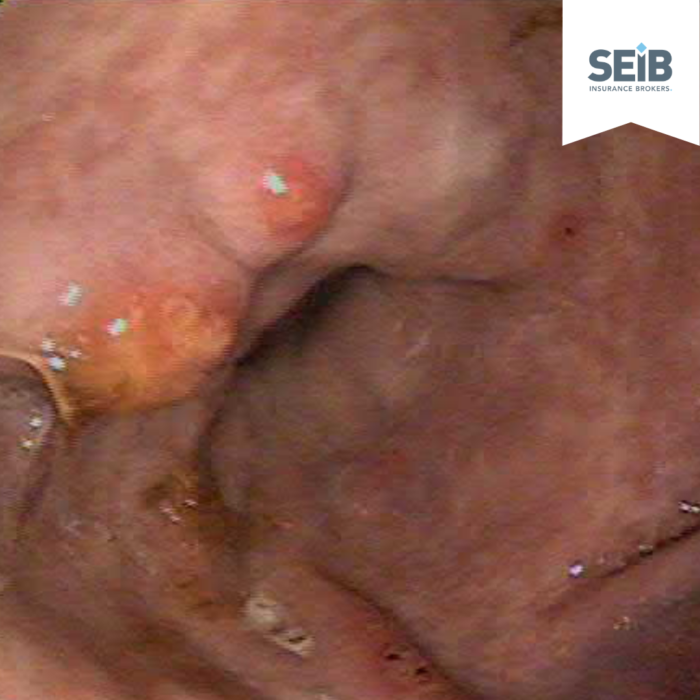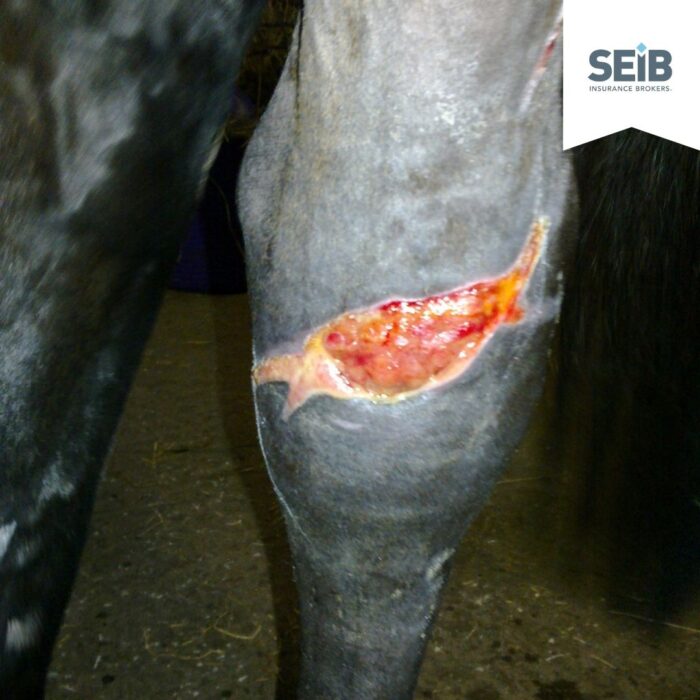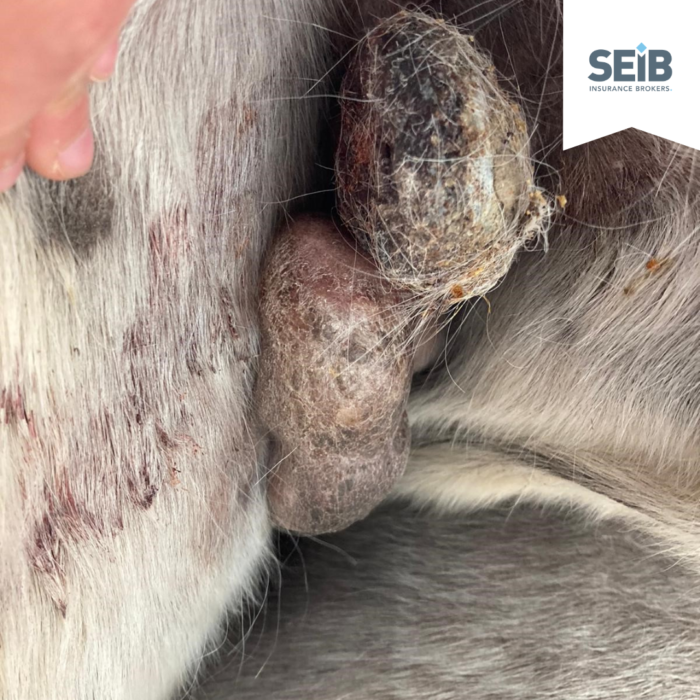Horse insurance claims are an everyday topic for SEIB Insurance Brokers, but for horse owners they can be incredibly stressful, both emotionally and financially. However well we look after and care for our horses and ponies, there are times when they will suffer from a range of different ailments. Many minor equine diseases and accidents will be simply resolved with common sense and care, but there are times when summoning the vet and putting in a subsequent horse insurance claim is unavoidable. This is after all, why we buy insurance for horses.
Analysis of insurance claims data has revealed that the top three cause of claims in 2021 were:
- Equine Gastric Ulcer Syndrome (EGUS)
- External trauma
- Skin diseases
Equine Gastric Ulcer Syndrome (EGUS)

EGUS is the erosion of the horse’s stomach lining caused by prolonged exposure to gastric acids such as hydrochloric acid, pepsin, bile acids and organic acids, that are all found in the horse’s stomach. Their stomachs produce these acids regardless of whether they’re eating or not. When the horse is eating the forage and saliva help to neutralise the acid, and when they are not eating this barrier is lost completely, causing the acid to splash again the stomach lining and potentially cause ulcers.
Any horse can be affected by this disease, but performance horses and racehorses have been found to be more likely to be impacted due to the intensity at which they’re exercised along with other factors that can trigger physical stress such as transportation and changing environments.
In 2021, SEIB saw over 100 claims for gastric ulcers, 44% of which cost over £3,000, and a further 17% reached SEIB’s veterinary fees limit of £5,000.
SEIB’s normal procedure is to consider treatment following a positive gastroscope, such as Gastrogard/Peptizole, for up to 28 days full dose and 28 days half dose (approximately 42 syringes), at which time they would require another gastroscopy to be performed to confirm that ulcers are still present, before they are able to consider the cost of further medication. Alternatively, they will consider a maximum of six weekly Omeprazole injections if this method is used, before requesting a further scope. In line with the normal terms and conditions of insurance, the policy does not provide any cover for preventative or maintenance treatment, and therefore no further reimbursement of fees will be paid once the ulcers have cleared.
EGUS case study: 6 year old | sport horse gelding | affiliated eventer BE90/100
In early December 2021 the horse exhibited ‘girthy’ behaviour and was generally unsettled. The vet was called, who attended the horse on the 10th December. The vet described the symptoms as “girthy and anxious” and performed a scope on the horse. Squamous ulceration and glandular ulceration (Gastric ulcers) were diagnosed and the horse was initially treated with Omeprazole injections and Sucralfate in his feed. The further treatment recommended was Omeprazole injections and re-scope in four weeks’ time. During a follow up examination 2 weeks later, the owner reported that the horse was doing much better, so they vet switched the treatment to Misoprostal syringes (4ml twice daily).
The horse was re-scoped as planned, the owner advised that the horse had shown an initial improvement in behaviour, however the behavioural changes had returned 2 weeks prior to the scope. Grade 4/4 squamous ulceration was shown on the re-scope, however the glandular ulceration looks almost healed. The vet discussed the options with the owner as they could continue with the Misoprostal syringes for a few weeks then switch to Omeprazole, or treat the squamous ulceration with Omeprazole now. The client opted to prioritise treating the squamous ulceration now with Omeprazole. The vet prescribed full dose of this medication for 4 weeks, then advised to reduce on tapering dose to try to avoid the return of the ulceration.
The horse was re-scoped and examined in March, the owner reported that the horse was still quite anxious under saddle but was improving. The scope revealed the squamous ulceration had resolved but the glandular ulceration has returned. The vet dispensed Misoprostal as it worked well last time and then to rescope again in 4 weeks’ time.
This claim has now reached the maximum veterinary fee limit of £5000, with treatment ongoing.
External trauma

External trauma is responsible for the second highest number of SEIB horse insurance claims in 2021.
On the face of it, wound treatment could be seen as one of the more ‘straight forward’ situations to deal with when calling the vet as there is often less diagnosis needed. However, having a visible cause of an issue doesn’t always make it the cheapest to treat.
SEIB had one case which was a wound caused by an accident in the field which reached the maximum level of veterinary fees cover of £5,000, and then went onto cost the owner a further £1,000. The horse had a large gash on its leg that had gone down to the bone causing damage to the underlying synovial structures. He was then referred to another veterinary practice for x-rays to confirm that there were no bone abnormalities, despite there being none, the wound repair had to be operated on under general anaesthetic, which played a big part in the cost of this claim.
Although the cost of treatment rarely reaches the £5,000 limit, the average cost still comes in at over £1,300.
Skin disease

The third most frequent cause of claims was skin disease. Equine skin diseases cover a wide range of problems, from fungal infections, allergies, rain scald, aural plaque, ringworm, mud fever, sweet itch and, of course, sarcoids which are a type of equine skin cancer. Many skin diseases can cause discomfort and itching for your horse and can be difficult to treat and cure completely,meaning that veterinary assistance is more often than not needed.
In 2021, SEIB dealt with many claims for skin disease, of which, 47% cost between £1,000 - £2,000 to settle, but one reached the £5,000 limit. The average claim cost for skin disease (including sarcoids) at SEIB in 2021 was £1,319.
The need for horse insurance
Advances in veterinary treatment and diagnostics over recent years have done wonders for helping our horses to live longer, healthier and happier lives. However, it has made calling the vet expensive.
As evidenced above, and probably through your own experiences, the cost of treating horses for ailments and injuries can easily rack up into the thousands, highlighting the need for horse insurance.
Many feel that with the rising cost of living, self-insurance may be the best option, but if we take the field injury claim price as an example, you would have needed to have saved in excess of £500 per month for a year to cover the total cost of £6,000, which far exceeds the average cost of a horse insurance premium. We don’t know if and when the worst will happen to our horses, but if it does, a horse insurance policy will be there to help you cover the costs.
About SEIB
SEIB have been arranging insurance for horses for over 50 years. This experience allows us to tailor policies to suit your circumstances and ensure that you and your horses are covered should the worst happen.
Our sincere thanks to Paton & Lee Equine Veterinary Surgery for allowing us to use their images.